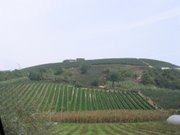A long mysterious title for this post... All these words relate to fat! As I mentioned in the previous post, we started being interested in lard some time ago. We got a first jar of 'manteca' in a Mexican store, which was the closest thing to lard we could find. We were both surprised it wasn't in the refrigerated section, and in fact it turned out that the box did not really just contain lard, but also a variety of hydrogenated fats, and most likely preservatives. Anyway, that was a good start, and we made really good tacos fried in lard, and pies such as the one I described in the previous post. Good stuff!
However, shortly after these first experiments, we also bought a huge amount of pork meat, and proceeded to cut it and freeze it as usual. Some pieces of fat scraps were left out, and Matt decided that instead of throwing them away, he would try to render them and make lard. So, here are the first two words of the title: grasso is fat, and strutto is lard. He cut the fat into cubes and boiled them with a little water, till most of the fat came out. Then he removed the solid pieces of fat leftover, and refrigerated the liquid. The fat solidified and the water remained below. After another round of boiling and solidification, he siphoned the water away and was left with nice looking, very bright lard. Unfortunately I don't have a picture of this first lard attempt. Another strawberry-rhubarb pie came out with the homemade lard, and the result was really good.
Excited by this success, we went to our favorite grocery store in the area: 99 Ranch, a Chinese grocery store in El Cerrito, where we get all our veggies and the best seafood in the area. Considering that they sell all sorts of meat (as you will read in a next post), we were sure we could buy pig fat there. However, at the store, the butcher, slightly embarrassed, told us that he didn't have any to sell us. Apparently the Mexicans in the area buy it all! Evidently, Mexicans know how to cook :). However, the butcher said, we could have some beef fat, instead. So, he just gave us completely for free 4 pounds of beef fat. Why couldn't we transform that into lard, we thought, going home.
I read online and on the food bible 'McGhee' about the difference between beef and pork fat. It turns out that rendered pork fat is lard, whereas rendered beef fat is tallow: strutto, in Italian, the first one, and sego the second one. I didn't know the meaning of sego or tallow before this experience. It also turns out tallow is used for cooking, however more for frying than for making pies. The reasons I found about this are contradictory: some people claim tallow has a stronger, beefy taste, than lard, whereas other people claim tallow doesn't taste like much, and therefore it just adds fat but no good flavor to pies. So, this was interesting to begin with: who was right? Matt started the rendering process right away. This time he tried to follow some more detailed recipes that we found online, such as this, on a new blog I found I really like (Homesick Texan).
He cut the beef fat into pieces and cooked them with water, similarly to what he did previously with pig fat:


Anyway, you won't believe me, but it was a fun experience. Possibly, not to be repeated any time soon, but worth a shot. Especially with pig fat, instead of beef fat, if you want to have the best pie crusts ever, and liberate yourself from the low-fat trend of our society!
Sunday, May 31, 2009
Grasso, strutto, sego
Posted by
chemcookit
at
8:10 PM
![]()
Subscribe to:
Post Comments (Atom)







2 comments:
i followed your comment on the homesick texan blog post about lard because i was interested in someone else's experience with beef tallow, which i wanted to try myself. thanks for your input... it stinks, apparently, and you have the risk of burning yourself, so i think i leave this one up to the organic butcher i go to and just pick it up from there.
your suggestion that lard is healthier than beef is based on the idea that saturated fat is bad for you. strange, coming from a european, where in europe they use much more animal fats than in canada and the use, and have a much smaller death rate due to clogged arteries and all that bad stuff. newer research that is not as well known suggests that people get heart attacks and strokes and all those bad-fat-related things from vegetable oils like soybean, cottonseed, canola, etc. that have been hydrogenated (as well as from ones that haven't been hydrogenated), as these oils are really hard to produce and require so many steps, they're completely unnatural by the time theyr'e "good enough" for public consumption.
when i was in spain, pigs hung from the window of every other shop... pork, beef, etc. are very popular foods... all animals and all very fatty full of saturated fat. yum. but the spanish are much healthier than north americans who like to stick to low fat everything. more and more, there are articles and documentaries out there to tell us that what we thought we knew about fats actually isn't true. it's worth a look.
my point.. i don't think beef tallow is less healthy than pork lard because of the amount of saturated fats. everything depends on how the animal was raised too, if it was naturally raised on grass or if it was stuffed up on by-products from the corn and soy industries, or worse, because all of those toxins go into the fat of the animal.
thanks for your post.. i just wanted to say all that stuff but i enjoyed your post. i know i won't be making lard or tallow at home, i'll just pick it up from the butcher. you may enjoy making your own butter, too... i tried that.. it's quite a process but doesn't smell... it's not as cost effective as buying butter, but if you wanted to make it yourself then it's good.. it tastes better.. the higher fat cream the better (whipping cream 35% should be a minimum fat content).
ciao!
Ciao T,
Sorry for the long delay in replying to your comment, which I thoroughly enjoyed reading.
First of all, I may have to write an addendum to this post: there are a few other ways that I read about how to render lard, which could be easier and wouldn't imply burning and stinking. One of them for example is to bake the fat in a closed container at low temperature for a few hours. Another is to boil the fat with more water, and not wait until the fat is all completely sunk to the bottom, but take it out after a while and squeeze it through a ricer -- then separate the fat from the water and add the squeezed stuff to it. This last version may also work better because it probably wouldn't give as much beefy or meaty taste to the resulting tallow or lard. We may try these methods if we ever run out of the tallow that Matt rendered. :)
I did a little research about the saturated/unsaturated fat topic. Apparently there is still a lot of consensus about the saturated fats being sort of 'bad', although everybody agrees that they are not as bad as the hydrogenated fats that you mentioned. The research on saturated fats seem to have also contradictory results, but for some reason the American Heart Association still discourages its consumption.
So, not sure what to make out of it. Mostly I think that most things that people eat without exceeding are good. I used to almost not eat any meat, and now I'm tempted to say that the meals I eat, with mostly meat and veggies, are healthier than having a lot of pasta and rice. At the same time, enjoying a really good pizza or pasta every once in a while is a pleasure that cannot be other than good for me.
So, how to conclude: I will try to make butter at some point, and eat it without feeling bad at all :)
Post a Comment